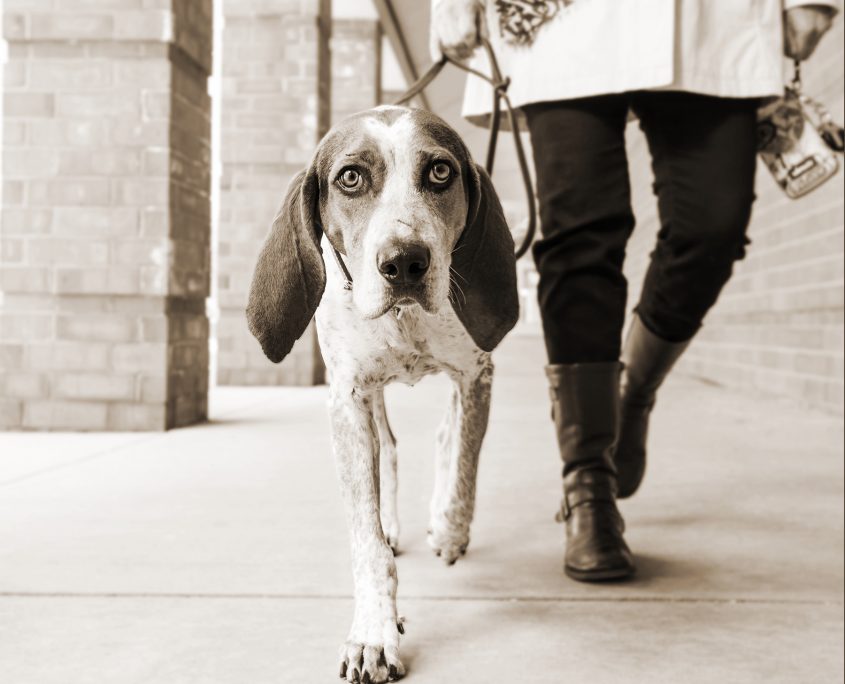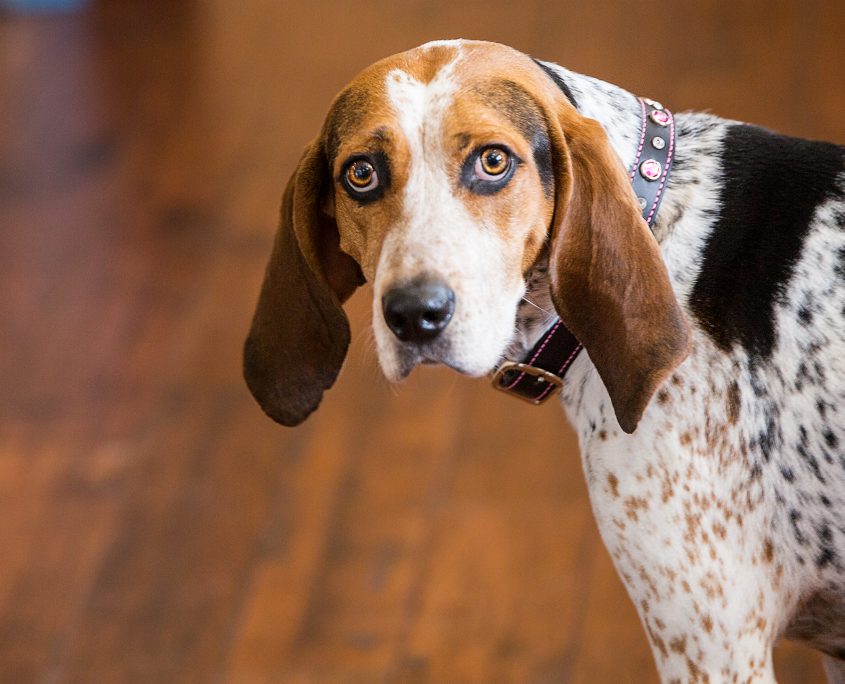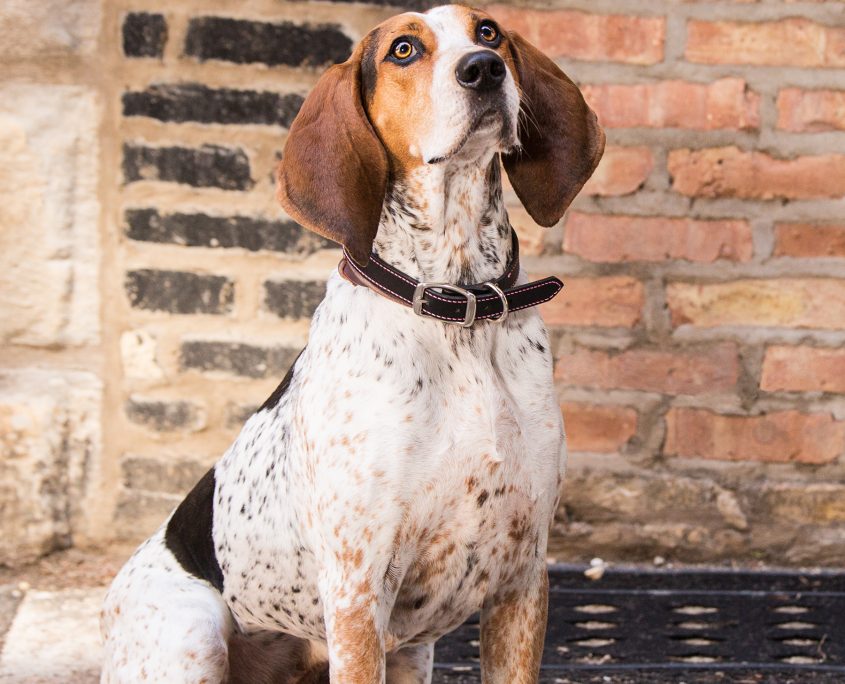Coonhounds: A Hometown Hound
By PAMELA STACE, Freelancer
Anna Nirva, co-founder of Coonhound & Foxhound Companions Inc. – an advocacy organization and shelter hound vet fund started in 2010 – and proud owner of a rescued American English Coonhound, makes a great case for the recognition and rescue of Coonhounds. “It’s their time,” she says, just as it happened with Pit Bulls and Greyhounds before them. Generally speaking, Nirva says people don’t know enough about homeless Coonhounds to seek them out for adoption. But she hopes to change this by raising public awareness and knowledge about Coonhounds or “Coonies”, the only breeds that were bred and developed in the United States.
What is a Coonhound?
There are six types: American English, Black and Tan, Bluetick, Plott Hound, Redbone and Treeing Walker. These breeds were developed in the eighteenth century by American settlers who needed dogs that could hunt over a variety of terrains, including heavily forested areas. The Plott, however, has some German ancestry. Each of the Coonhound breeds look a little different, but they all share the distinction of having soft, long ears. They are also all highly prey-driven, with a superior hunting instinct.
Coonhounds were bred to be rugged, determined, brave, fearless, tenacious and vocal in the pursuit of raccoons, bears, boars and other game. But they have also been described as sweetly gentle, loving, even-tempered, amiable and mellow.
Nirva says that although all Coonhounds are born with specific traits, not every breed exhibits all of these traits. She emphasizes that much like the variety of coat colors and patterns that occur in Coonies, there are more differences between individual dogs than between breeds. There are Coonhound tendencies, but there is no one Coonhound template.
Because they are pack-oriented however, Coonies are good around both people (including kids) and other dogs. They have good social skills and can adapt well to various indoor and outdoor environments; but they do require patient and kind training. Coonies can be used in agility, therapy, search and rescue, conformation and obedience. They also have an “on/off” switch meaning they are not 24/7 goers. Although they are more than happy to participate in activities, when the “job” is done, they are quite ready for leisure time!
A Coonie might not be the dog for you if you cannot provide adequate exercise time and space, or if you cannot ensure that he won’t take off. As a Scent hound, a Coonie can climb a tree or fence if his nose picks up something appealing. And they can be loud! Coonhounds were bred to let you know when they have found their prey. “The Bay,” as it is called, can consist of a variety of tones from soft and subtle to a loud, prolonged song. Again, every individual dog will be different!
Health Concerns
Coonhounds are still very popular today with hunters, especially in the South, and in a sense that heritage has kept Coonies pretty healthy. They are not prone to hip or joint problems, but may suffer from allergies.
Why the Need for Rescue Now?
There are a lot of Coonhounds in the South, and they are tremendously valued there as hunting dogs. However, because they are all individuals with differing abilities, they don’t all turn out to be great hunters. There are few, if any, no kill shelters in the South, and there is a lot of overcrowding.
In his story “Northbound Toward Home” on bittersoutherner.com, Cy Brown specifically chronicles a rescue trip by Peterson Express Transport Services from Tennessee to shelters in the North East. Brown says that in the South “more than a million healthy, adoptable dogs are put down every year.” He says that there is less municipal money for animal control and care there, and there is a resistance to spaying and neutering. The bottom line is that the supply of dogs needing forever homes far exceeds the demand for them. Using big rigs and teams of truck drivers and dog walkers, P.E.T.S. regularly delivers Southern dogs to better homes in the North.
Closer to home, Chris and Daphne Roy work in the Midwest, and as the founders of Doobert.com – a software that helps individuals plan transports and fundraisers, find fosters, photographers and much more – they oversee animal transport to rescues and shelters locally, nationally and internationally. Nirva is full of praise for Doobert, and she works with them often. She volunteers tirelessly for Coonhounds in Wisconsin through education, advocacy and shelter work. Locally, she is especially involved with the Elmbrook Humane Society, which has been particularly receptive to Coonhound arrivals and adoptions. Anna was happy to say that “word is getting out” about Coonhounds in need, but that rescue efforts still need to be stronger. And isn’t it about time for our only truly American breeds to take center stage?
Coonie Stats:
American English Coonhound
White Coat with Blue or
Red Tick Coloration
Male Height: 22-27” Weight: 40-65#
Female Height: 21-25” Weight: 40-65#
Lifespan: 11-12 Years
Black and Tan Coonhound
Black Coat with Tan Trim
Male Height: 25-27” Weight: 65-75#
Female Height: 23-25” Weight: 55-70#
Lifespan: 10-12 Years
Bluetick Coonhound
White Coat with Heavy Blue Ticking
Male Height: 22-27” Weight: 55-80#
Female Height: 21-25” Weight: 45-64#
Lifespan: 11-12 Years
Plott Hound
Brindle
Male Height: 20-28” Weight: 51-60#
Female Height: 20-23” Weight: 40-55#
Lifespan: 12-14 Years
Redbone Coonhound
Solid Red
Male Height: 22-27″ Weight: 50-70#
Female Height: 21-26” Weight: 45-70#
Lifespan: 11-12 Years
Treeing Walker Coonhound
White, Black & Chestnut Markings
Male Height: 22-27” Weight: 50-70#
Female Height: 20-25” Weight: 50-70#
Lifespan: 12-13 Years
Original Job: Hunting & Treeing Game
Grooming: Minimal, Check Ears






